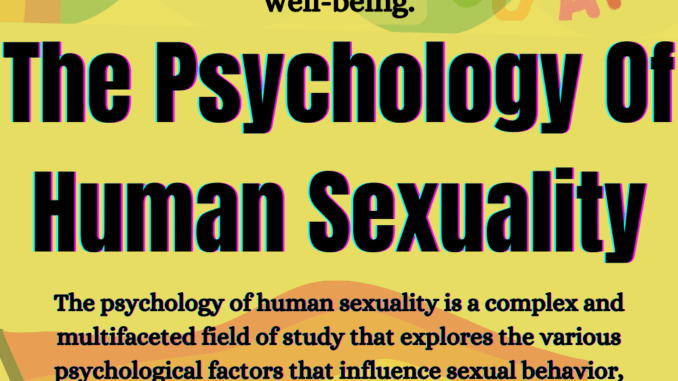
Sexuality Definition|Meaning
Sexuality is a complex and multifaceted aspect of human identity that refers to an individual’s sexual feelings, attractions, desires, and behaviors. It encompasses a broad range of experiences and expressions, including sexual orientation, gender identity, sexual preferences, and sexual practices.
Sexuality is influenced by a variety of factors, including biology, culture, society, and personal experiences. It is an important aspect of human life and can have a profound impact on an individual’s relationships, self-esteem, and overall well-being.
Human Sexuality Meaning
Human sexuality is the way in which individuals express their sexual desires, attractions, and behaviors. It encompasses a wide range of experiences and expressions, including sexual orientation, gender identity, romantic attraction, and sexual behavior. Human sexuality is influenced by a variety of factors, including biological, psychological, social, and cultural factors.
Some common aspects of human sexuality include sexual development, sexual health, sexual pleasure, and sexual relationships. Understanding and accepting human sexuality is important for individuals to live healthy and fulfilling lives, as well as for creating inclusive and respectful communities
The Psychology Of Human Sexuality
The psychology of human sexuality is a complex and multifaceted field of study that explores the various psychological factors that influence sexual behavior, attitudes, and experiences. Some of the key areas of research in this field include:
- Sexual orientation: The study of sexual orientation seeks to understand the factors that influence a person’s sexual attraction to others. Researchers examine biological, psychological, and social factors that may contribute to sexual orientation, including genetic predisposition, hormonal influences, childhood experiences, and cultural norms.
- Gender identity: The study of gender identity explores how individuals perceive and define their gender, which can have a significant impact on their sexual experiences and behaviors. Researchers investigate how biological and environmental factors interact to shape gender identity, as well as how social and cultural norms may influence gender expression and sexual behavior.
- S3xual arousal and response: The study of sexual arousal and response examines the physical and psychological processes that occur during sexual activity, including the role of hormones, neurotransmitters, and psychological factors such as mood and emotional state.
- S3xual dysfunction: Sexual dysfunction refers to a range of difficulties that can interfere with sexual function and satisfaction, including erectile dysfunction, premature ej@culati0n, and low sexual desire. Researchers investigate the psychological and biological factors that contribute to sexual dysfunction, as well as interventions that can help individuals overcome these challenges.
- Sexual risk-taking and health: The study of sexual risk-taking and health explores how individuals make decisions about sexual behavior, including the use of contraception and the transmission of sexually transmitted infections. Researchers also examine the impact of sexual behavior on physical and mental health, including the development of depression, anxiety, and other mental health conditions.
The psychology of human sexuality is a complex and evolving field that seeks to understand the many factors that contribute to our sexual experiences and behaviors. Through continued research and exploration, psychologists can help individuals better understand their own sexuality and improve their sexual health and well-being.
Sexuality Definition Psychology
Sexuality is a broad term used in psychology to refer to a person’s sexual preferences, feelings, and behaviors. It encompasses various aspects of human sexuality, including sexual attraction, sexual orientation, gender identity, and sexual behavior.
Sexual attraction refers to the subjective experience of finding someone sexually desirable, while sexual orientation refers to the gender or genders to which a person is attracted. Gender identity is a person’s internal sense of being male, female, or somewhere in between, regardless of their biological sex.
Sexual behavior refers to any actions that are intended to sexually arouse or gratify oneself or others, including sexual intercourse, masturbation, and other sexual activities.
The study of human sexuality is an important area of research in psychology, as it can provide insight into various aspects of human behavior and relationships, as well as inform policies and interventions related to sexual health and well-being.
Types Of Sexuality
1. Heterosexual (Straight): Feeling sexual attraction to people of the opposite sex/gender.
2. Homosexual (Gay/Lesbian): Feeling sexual attraction to people of the same sex/gender. Gay men are attracted to men, lesbians are attracted to women.
3. Bisexual: Feeling sexual attraction to more than one gender. This can be men, women, non-binary individuals, etc.
4. Asexual: Experiencing little to no sexual attraction to anyone. Asexuality is a spectrum, and some asexual people may experience infrequent attraction.
5. Pansexual: Feeling sexual attraction to people regardless of their gender identity. Pansexual people are attracted to the person, not their gender.
6. Demisexual: Only experiencing sexual attraction after forming a strong emotional bond with someone.
7. Sapiosexual: Feeling sexual attraction to intelligence.
8. Graysexual: Identifying somewhere on the spectrum between sexual and asexual. Graysexual people may experience sexual attraction very infrequently or weakly.
9. Fraysexual: Experiencing sexual attraction that fades over time or with emotional intimacy.
10. Libisexual: Fluctuating sexual attraction. Libisexual people may identify as bisexual, homosexual, or asexual at different points in their lives.
11. Polysexual: Feeling sexual attraction to several genders, but not all.
12. Objectumsexual: Feeling sexual attraction to inanimate objects.
13. Fictosexual: Feeling sexual attraction to fictional characters.
14. Autosexual: Feeling sexual attraction to oneself.
15. Queer: An umbrella term for people who don’t identify as heterosexual or cisgender. It can be a sexual orientation or a broad identity encompassing gender and sexuality.
Human Sexuality
Human sexuality and sexual desire are complex and multifaceted aspects of human behavior that have intrigued scholars, scientists, and the general public for centuries. The study of human sexuality and sexual desire encompasses a range of topics, including sexual orientation, gender identity, sexual dysfunction, sexual health, and the influence of cultural and social factors on sexual behavior.
This article explores some of the latest research and theories related to human sexuality and sexual desire, providing insights into the complexities of these topics.
Human sexuality and sexual desire are fundamental aspects of human life, shaping our relationships, self-identity, and physical and emotional health. Sexual desire refers to the physical and psychological urge to engage in sexual activity, which can be influenced by a range of biological, psychological, social, and cultural factors.
The study of human sexuality and sexual desire is a multidisciplinary field that draws on insights from psychology, biology, sociology, anthropology, and other disciplines. Researchers have explored a wide range of topics related to human sexuality and sexual desire, including the impact of hormones, genetics, and brain structure on sexual behavior, the role of culture and social norms in shaping sexual attitudes and practices, and the impact of sexual dysfunction on individuals and relationships.
One area of particular interest is the relationship between sexual desire and mental health. Research suggests that individuals with higher levels of sexual desire tend to have better mental health outcomes, such as lower rates of depression and anxiety, but the direction of causality is not always clear. Similarly, issues related to sexual dysfunction, such as low libido or erectile dysfunction, can have a significant impact on an individual’s mental health and well-being, as well as their relationships.
Another area of interest is the relationship between sexual desire and gender identity. Research has shown that gender identity and sexual desire are complex and interrelated constructs, with individuals experiencing a wide range of gender and sexual orientations. Understanding the diversity and complexity of gender and sexual identity is essential for promoting sexual health and well-being for all individuals.
Human Sexuality
Human sexuality refers to the way that humans experience and express their sexual desires, attractions, behaviors, and identities. It encompasses a wide range of physical, emotional, and psychological factors that shape how individuals relate to themselves and others in terms of sexual desire and behavior.
Sexual desire can be experienced in a variety of ways, and people can be attracted to others based on a range of factors, including physical appearance, personality, social status, and shared interests. Sexual behaviors can include a range of activities, from masturbation and sexual intercourse to oral sex and other forms of intimate contact.
Sexual identity refers to the way individuals define themselves in terms of their sexual orientation, gender identity, and relationship preferences. Sexual orientation refers to a person’s emotional and physical attraction to others, which can be categorized as heterosexual, homosexual, bisexual, or asexual.
Gender identity refers to a person’s internal sense of being male, female, or somewhere in between, which may or may not align with the gender they were assigned at birth. Relationship preferences refer to the way individuals prefer to engage in sexual relationships, which can range from monogamy to polyamory.
Human sexuality is a complex and multifaceted topic that has been studied by scholars, researchers, and health professionals for decades. While it is influenced by biological, psychological, and social factors, it is also shaped by cultural and societal norms, which can vary widely across different communities and regions of the world.
Sexual Desire
Different Ways Sexual Desire Can Be Experienced
- Physical sensations: Sexual desire can be experienced as physical sensations, such as a tingling or warming feeling in the genitals or a feeling of tension or pressure in the body.
- Emotional arousal: Sexual desire can also be experienced as emotional arousal, such as feeling excited, passionate, or eager to engage in sexual activity.
- Fantasy and imagination: Sexual desire can involve fantasies and imagination, where a person may imagine different sexual scenarios, partners, or activities that can arouse them.
- Visual stimulation: Some people may experience sexual desire through visual stimulation, such as watching p0rn or looking at erotic images.
- Sensory stimulation: Sexual desire can also be experienced through sensory stimulation, such as touch, taste, smell, and sound.
- Hormonal changes: Hormonal changes, such as an increase in testosterone or estrogen levels, can also contribute to feelings of sexual desire.
- Psychological factors: Psychological factors such as stress, anxiety, depression, or past trauma can influence sexual desire and make it difficult to experience.
It is important to note that sexual desire is a highly individual experience, and what may be arousing for one person may not be arousing for another. It is important to communicate with sexual partners and be open to exploring and understanding each other’s desires and preferences.
What Is Sexuality
Sexuality is a term used to describe a person’s sexual preferences, attractions, behaviors, and desires. It encompasses a wide range of biological, psychological, and social factors that influence how individuals experience and express their sexual identity.
Sexuality can be influenced by a variety of factors, including genetic, hormonal, cultural, and social factors. It can include sexual attraction to others, sexual fantasies and desires, sexual behaviors, and gender identity. Sexual attraction can be directed towards individuals of the same gender, opposite gender, or both genders, and can be experienced in varying degrees.
Sexuality is an important aspect of human life and is a fundamental part of our identity. It can shape our relationships, our self-concept, and our experiences with others. The study of human sexuality is an important area of research in psychology, as it can provide insight into various aspects of human behavior and relationships, as well as inform policies and interventions related to sexual health and well-being.
How Many Types Of Sexualities Are There
Sexual orientation is a complex and multifaceted construct, and there are many different ways that people experience and identify their sexuality. While there is no comprehensive list of all the possible sexual orientations, some of the most commonly recognized types of sexual orientation include:
- Heterosexual: Individuals who are primarily sexually attracted to individuals of the opposite gender.
- Homosexual: Individuals who are primarily sexually attracted to individuals of the same gender.
- Bisexual: Individuals who are sexually attracted to individuals of both genders.
- Pansexual: Individuals who are attracted to individuals of all genders, regardless of their gender identity.
- Asexual: Individuals who do not experience sexual attraction or desire.
- Demisexual: Individuals who experience sexual attraction only after developing a strong emotional connection with someone.
- Greysexual: Individuals who experience sexual attraction infrequently or only under specific circumstances.
- Queer: An umbrella term used by some individuals to describe their non-heterosexual orientation, which may not fit into any of the above categories.
It is important to note that sexual orientation is a complex and fluid construct, and individuals may experience changes in their sexual orientation over time or across different contexts. Additionally, some individuals may not identify with any specific sexual orientation label or may identify with multiple labels. It is ultimately up to each individual to determine how they wish to define their sexuality.
How Many Genders Are There
The concept of gender varies across cultures and can be understood in different ways. In many societies, gender is seen as a binary system, with only two genders: male and female. However, some cultures and societies recognize non-binary genders, which may include genderqueer, genderfluid, agender, and others.
It is important to note that gender identity is a deeply personal and individual experience, and people may identify in ways that don’t necessarily fit within established categories or labels. Therefore, it is difficult to provide a definitive answer to this question, as gender is a complex and multifaceted concept that can be understood in different ways by different people and cultures.
Pansexual
Pansexuality is a sexual orientation that refers to the potential for sexual attraction, romantic love, or emotional attraction to people of any gender identity or expression. Pansexual individuals may be attracted to people who identify as male, female, non-binary, genderqueer, transgender, or any other gender identity.
Pansexuality is sometimes described as being “gender-blind,” as it recognizes that gender is not a defining factor in a person’s attraction to someone else. Instead, pansexual individuals may be attracted to a person’s personality, physical appearance, or other factors unrelated to gender.
It’s important to note that pansexuality is just one of many different sexual orientations that people may identify with, and everyone’s experiences with their own sexuality are unique and valid.
Sexual Identity Vs Sexual Orientation
The terms “sexual identity” and “sexual orientation” are often used interchangeably, but they have slightly different meanings.
Sexual identity refers to a person’s internal sense of their own sexuality and how they choose to express it. It includes factors such as sexual attraction, sexual behavior, and sexual fantasies, as well as a person’s gender identity and expression.
Sexual orientation, on the other hand, refers to the gender or genders to which a person is primarily sexually attracted. This can include being attracted to people of the same gender (homosexual), opposite gender (heterosexual), or multiple genders (bisexual, pansexual, etc.).
In essence, sexual identity encompasses a broader range of factors beyond just sexual attraction, such as a person’s gender identity and the way they choose to express their sexuality. Sexual orientation is more focused on the specific gender or genders to which a person is attracted.
It’s worth noting that both terms are complex and multifaceted, and people may use them in different ways or have different interpretations of what they mean. Ultimately, what matters most is that individuals are able to express and explore their sexuality in a way that feels authentic and fulfilling to them.
Sexual Orientation Test
Sexual orientation is a personal aspect of one’s identity, and there are no definitive tests or quizzes to determine it. It’s something that an individual may discover over time through self-exploration, self-reflection, and interpersonal experiences. If you have questions about your sexuality or identity, it may be helpful to seek support from a mental health professional or a trusted friend or family member.
How Many Genders Are There
Gender refers to a complex interplay of biological, psychological, and cultural factors that contribute to one’s sense of self and identity. While traditionally two genders (male and female) have been recognized, there is increasing recognition of non-binary or gender non-conforming identities.
Therefore, it is important to understand that gender is a spectrum and can vary across cultures, individuals, and time periods. Ultimately, it is up to individuals to define and express their own gender identity.
Conclusion
Human sexuality and sexual desire are complex and multifaceted aspects of human behavior that have important implications for individual well-being, interpersonal relationships, and society as a whole.
By gaining a deeper understanding of the factors that influence human sexual behavior and desire, we can better address issues related to sexual health, gender identity, and sexual dysfunction. It is important to continue exploring these topics through research, dialogue, and education in order to promote healthy and fulfilling sexual experiences for all individuals.



1 Trackback / Pingback
Comments are closed.